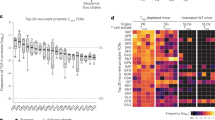Abstract
THE T-cell antigen receptor is a heterodimer molecule composed of either αβ or γδ chains. The αβ receptor molecules are expressed mainly in CD4+ CD8− and CD4−CD8+ T cells (helper and killer T cells respectively), whereas the γδ receptor molecules are expressed mainly in CD4−CD8- T cells1–3. CD4+CD8− and CD4−CD8+ T cells arise from a class of CD4−CD8− T cells during thymus development4, raising the question of whether cells rearranging their γδ receptors later give rise to αβ T cells by further rearrangements of their receptor genes, or whether rearrangements and expression of the receptor genes occur in separate lineages. The δ -chain gene is located between the Vα (variable) and Jα(joining) gene segments5,6 and when the rearrangements allowing α- and β-receptors occur, the DNA between these segments is deleted as small circles which can be isolated from developing thymocytes7,8. The rearrangement status of the δ -chain gene in the α-circles can therefore be investigated to see whether α-chain and δ -chain expression occur in parallel lineages or sequentially within a lineage. We find that the δ -chain gene in the T-cell receptor α-circles has a germline configuration, indicating that αβ and γδ T cells are distinct lineages.
This is a preview of subscription content, access via your institution
Access options
Subscribe to this journal
Receive 51 print issues and online access
$199.00 per year
only $3.90 per issue
Buy this article
- Purchase on Springer Link
- Instant access to full article PDF
Prices may be subject to local taxes which are calculated during checkout
Similar content being viewed by others
References
Kronenberg, M., Siu, G., Hood, L. E. & Shastri, N. A. Rev. Immun. 4, 529–591 (1986).
Davis, M. M. & Bjorkman, P. J. Nature 334, 395–402 (1988).
Toyonaga, B. & Mak, T. W. A. Rev. Immun. 5, 585–620 (1987).
von Boehmer, H. A. Rev. Immun. 6, 309–326 (1988).
Chien, Y. et al. Nature 330, 722–727 (1987).
Chien, Y., Iwashima, M., Kaplan, K. B., Elliott, J. F. & Davis, M. M. Nature 328, 677–682 (1987).
Fujimoto, S. & Yamagishi, H. Nature 327, 242–243 (1987).
Okazaki, K., Davis, D. D. & Sakano, H. Cell 49, 477–485 (1987).
Winoto, A., Mjolsness, S. & Hood, L. E. Nature 316, 832–836 (1985).
Okazaki, K. & Sakano, H. EMBO J. 7, 1669–1674 (1988).
de Villartay, J. P. et al. Proc. natn. Acad. Sci. U.S.A. 84, 8605–8612 (1987).
de Villartay, J. P., Hockett, R. D., Coran, D., Korsmeyer, S. J. & Cohen, D. Nature 336, 170–174 (1988).
Pardoll, D. M. et al. Nature 326, 79–81 (1987).
Steinmetz, M., Winoto, A., Minard, K. & Hood, L. Cell 28, 489–498 (1982).
Author information
Authors and Affiliations
Rights and permissions
About this article
Cite this article
Winoto, A., Baltimore, D. Separate lineages of T cells expressing the αβ and γδ receptors. Nature 338, 430–432 (1989). https://doi.org/10.1038/338430a0
Received:
Accepted:
Issue Date:
DOI: https://doi.org/10.1038/338430a0
This article is cited by
-
Apoptosis in the development of the immune system: Growth factors, clonal selection and bcl-2
Cancer and Metastasis Review (1992)
-
Self-reactive γδ T cells are eliminated in the thymus
Nature (1990)
-
The role ofγδ T cells in the normal and disordered immune system
Klinische Wochenschrift (1990)
-
T-Cell receptor and autoimmune disease
Immunologic Research (1990)
-
Newly identified ?? and ?? T-cell receptors
Journal of Clinical Immunology (1990)
Comments
By submitting a comment you agree to abide by our Terms and Community Guidelines. If you find something abusive or that does not comply with our terms or guidelines please flag it as inappropriate.



